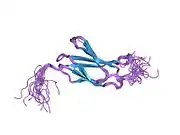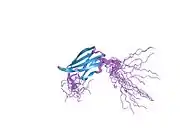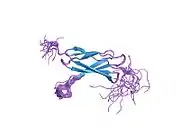Tenascin X
A member of the tenascin family, tenascin X (TN-X) also known as flexillin or hexabrachion-like protein is a 450kDa glycoprotein that is expressed in connective tissues. TN-X possesses a modular structure composed, from the N- to the C-terminal part by a Tenascin assembly domain (TAD), a series of 18.5 repeats of epidermal growth factor (EGF)-like motif, a high number of Fibronectin type III (FNIII) module, and a fibrinogen (FBG)-like globular domain.[5] In humans, tenascin X is encoded by the TNXB gene.[6]
| TNXB | |||||||||||||||||||||||||||||||||||||||||||||||||||
|---|---|---|---|---|---|---|---|---|---|---|---|---|---|---|---|---|---|---|---|---|---|---|---|---|---|---|---|---|---|---|---|---|---|---|---|---|---|---|---|---|---|---|---|---|---|---|---|---|---|---|---|
 | |||||||||||||||||||||||||||||||||||||||||||||||||||
| |||||||||||||||||||||||||||||||||||||||||||||||||||
| Identifiers | |||||||||||||||||||||||||||||||||||||||||||||||||||
| Aliases | TNXB, EDS3, HXBL, TENX, TN-X, TNX, TNXB1, TNXB2, TNXBS, VUR8, XB, XBS, tenascin XB, EDSCLL, EDSCLL1 | ||||||||||||||||||||||||||||||||||||||||||||||||||
| External IDs | OMIM: 600985 MGI: 1932137 HomoloGene: 49589 GeneCards: TNXB | ||||||||||||||||||||||||||||||||||||||||||||||||||
| |||||||||||||||||||||||||||||||||||||||||||||||||||
| |||||||||||||||||||||||||||||||||||||||||||||||||||
| |||||||||||||||||||||||||||||||||||||||||||||||||||
| |||||||||||||||||||||||||||||||||||||||||||||||||||
| |||||||||||||||||||||||||||||||||||||||||||||||||||
| Wikidata | |||||||||||||||||||||||||||||||||||||||||||||||||||
| |||||||||||||||||||||||||||||||||||||||||||||||||||
Gene
This gene localizes to the major histocompatibility complex (MHC class III) region on chromosome 6. The structure of this gene is unusual in that it overlaps the CREBL1 and CYP21A2 genes at its 5' and 3' ends, respectively.[7] TNXB also possesses a pseudogene, TNXA, which is a consequence of MHC classe III locus duplication during evolution. Strong 3' homology between TNXB and TNXA can provoke genetic recombination between the two loci, thus leading to the apparition of TNXA/TNXB chimera[8].
Function
TN-X is constitutively expressed in adult tissues such as skin, ligaments, tendons, lungs, kidneys, optic nerves, mammary and adrenal glands, blood vessels, testis, and ovaries. It is also found in different compartments of the digestive tract, including pancreas, stomach, jejunum, ileum, and colon. In this wide variety of organs, TN-X is mainly located within the connective tissue such as peritendineum (external structural component of tendons), epimysium and perimysium (muscle components), renal glomeruli, blood vessels and skin dermis.[9] TN-X has been proposed to have an important structural and architectural function, especially within the skin. In fact, in vitro experiments demonstrate that TN-X physically interacts with fibrillar collagens type I, III and V, as well as FACIT (Fibrillar Associated Collagen with Interruption of the Triple helix) including type XII and XIV collagens.[10] It also interacts with Transforming Growth Factor (TGF)-β[11] which is a pro-fibrotic cytokine and Decorin, a small 100 kDa dermatan sulfate proteoglycan that plays a crucial role in collagen fibrillogenesis.[12] In vivo, transmission electron microscopy coupled with immuno-labelling confirms the very close location of TN-X with collagen fibbers in dermis, tendons and kidney glomeruli.[13]
In addition to this architectural function, TN-X also demonstrated counter-adhesive properties, at least for human osteosarcoma cells (MG-63), murine embryonic fibroblasts (MRC-5) as well as human endothelial cells (ECV-304).[14][15]
Clinical significance
Homozygous mutations,[16] heterozygous compound (bi-allelic) mutations[17] or haploinsufficiency[8] in TN-X cause classical-like Ehlers-Danlos syndrome (EDS),[18] a rare and hereditary connective tissue disorder in mice[19] and human.[20][21] This pathology is characterized by skin hyperlaxity, joint hypermobility and global tissue weakness as a consequence of elastin fragmentation and reduced collagen density, especially in skin.[22][23]
References
- ENSG00000236221, ENSG00000229353, ENSG00000229341, ENSG00000233323, ENSG00000231608, ENSG00000206258, ENSG00000168477 GRCh38: Ensembl release 89: ENSG00000236236, ENSG00000236221, ENSG00000229353, ENSG00000229341, ENSG00000233323, ENSG00000231608, ENSG00000206258, ENSG00000168477 - Ensembl, May 2017
- GRCm38: Ensembl release 89: ENSMUSG00000033327 - Ensembl, May 2017
- "Human PubMed Reference:". National Center for Biotechnology Information, U.S. National Library of Medicine.
- "Mouse PubMed Reference:". National Center for Biotechnology Information, U.S. National Library of Medicine.
- Jones FS, Jones PL (June 2000). "The tenascin family of ECM glycoproteins: structure, function, and regulation during embryonic development and tissue remodeling". Developmental Dynamics. 218 (2): 235–259. doi:10.1002/(SICI)1097-0177(200006)218:2<235::AID-DVDY2>3.0.CO;2-G. PMID 10842355. S2CID 16267174.
- Tee MK, Thomson AA, Bristow J, Miller WL (July 1995). "Sequences promoting the transcription of the human XA gene overlapping P450c21A correctly predict the presence of a novel, adrenal-specific, truncated form of tenascin-X". Genomics. 28 (2): 171–178. doi:10.1006/geno.1995.1128. PMID 8530023.
- "Entrez Gene: tenascin XB".
- Merke DP, Chen W, Morissette R, Xu Z, Van Ryzin C, Sachdev V, et al. (February 2013). "Tenascin-X haploinsufficiency associated with Ehlers-Danlos syndrome in patients with congenital adrenal hyperplasia". The Journal of Clinical Endocrinology and Metabolism. 98 (2): E379–E387. doi:10.1210/jc.2012-3148. PMC 3565116. PMID 23284009.
- Valcourt U, Alcaraz LB, Exposito JY, Lethias C, Bartholin L (2015-01-02). "Tenascin-X: beyond the architectural function". Cell Adhesion & Migration. 9 (1–2): 154–165. doi:10.4161/19336918.2014.994893. PMC 4422802. PMID 25793578.
- Lethias C, Carisey A, Comte J, Cluzel C, Exposito JY (November 2006). "A model of tenascin-X integration within the collagenous network". FEBS Letters. 580 (26): 6281–6285. doi:10.1016/j.febslet.2006.10.037. PMID 17078949. S2CID 29297624.
- Alcaraz LB, Exposito JY, Chuvin N, Pommier RM, Cluzel C, Martel S, et al. (May 2014). "Tenascin-X promotes epithelial-to-mesenchymal transition by activating latent TGF-β". The Journal of Cell Biology. 205 (3): 409–428. doi:10.1083/jcb.201308031. PMC 4018787. PMID 24821840.
- Elefteriou F, Exposito JY, Garrone R, Lethias C (April 2001). "Binding of tenascin-X to decorin". FEBS Letters. 495 (1–2): 44–47. doi:10.1016/S0014-5793(01)02361-4. PMID 11322944. S2CID 13988411.
- Lethias C, Descollonges Y, Boutillon MM, Garrone R (April 1996). "Flexilin: a new extracellular matrix glycoprotein localized on collagen fibrils". Matrix Biology. 15 (1): 11–19. doi:10.1016/S0945-053X(96)90122-5. PMID 8783183.
- Elefteriou F, Exposito JY, Garrone R, Lethias C (August 1999). "Cell adhesion to tenascin-X mapping of cell adhesion sites and identification of integrin receptors". European Journal of Biochemistry. 263 (3): 840–848. doi:10.1046/j.1432-1327.1999.00563.x. PMID 10469149.
- Fujie S, Maita H, Ariga H, Matsumoto K (October 2009). "Tenascin-X induces cell detachment through p38 mitogen-activated protein kinase activation". Biological & Pharmaceutical Bulletin. 32 (10): 1795–1799. doi:10.1248/bpb.32.1795. PMID 19801846.
- Morissette R, Chen W, Perritt AF, Dreiling JL, Arai AE, Sachdev V, et al. (August 2015). "Broadening the Spectrum of Ehlers Danlos Syndrome in Patients With Congenital Adrenal Hyperplasia". The Journal of Clinical Endocrinology and Metabolism. 100 (8): E1143–E1152. doi:10.1210/jc.2015-2232. PMC 4525000. PMID 26075496.
- Chen W, Perritt AF, Morissette R, Dreiling JL, Bohn MF, Mallappa A, et al. (September 2016). "Ehlers-Danlos Syndrome Caused by Biallelic TNXB Variants in Patients with Congenital Adrenal Hyperplasia". Human Mutation. 37 (9): 893–897. doi:10.1002/humu.23028. PMC 4983206. PMID 27297501.
- Malfait F, Francomano C, Byers P, Belmont J, Berglund B, Black J, et al. (March 2017). "The 2017 international classification of the Ehlers-Danlos syndromes". American Journal of Medical Genetics. Part C, Seminars in Medical Genetics. 175 (1): 8–26. doi:10.1002/ajmg.c.31552. PMID 28306229. S2CID 4440499.
- Mao JR, Taylor G, Dean WB, Wagner DR, Afzal V, Lotz JC, et al. (April 2002). "Tenascin-X deficiency mimics Ehlers-Danlos syndrome in mice through alteration of collagen deposition". Nature Genetics. 30 (4): 421–425. doi:10.1038/ng850. PMID 11925569. S2CID 21274161.
- Schalkwijk J, Zweers MC, Steijlen PM, Dean WB, Taylor G, van Vlijmen IM, et al. (October 2001). "A recessive form of the Ehlers-Danlos syndrome caused by tenascin-X deficiency". The New England Journal of Medicine. 345 (16): 1167–1175. doi:10.1056/NEJMoa002939. hdl:2066/185552. PMID 11642233. S2CID 42748708.
- Demirdas S, Dulfer E, Robert L, Kempers M, van Beek D, Micha D, et al. (March 2017). "Recognizing the tenascin-X deficient type of Ehlers-Danlos syndrome: a cross-sectional study in 17 patients". Clinical Genetics. 91 (3): 411–425. doi:10.1111/cge.12853. PMID 27582382. S2CID 205001452.
- Zweers MC, Schalkwijk J, van Kuppevelt TH, van Vlijmen-Willems IM, Bergers M, Lethias C, Lamme EN (February 2005). "Transplantation of reconstructed human skin on nude mice: a model system to study expression of human tenascin-X and elastic fiber components". Cell and Tissue Research. 319 (2): 279–287. doi:10.1007/s00441-004-1011-6. PMID 15558324. S2CID 5889106.
- Voermans NC, Jenniskens GJ, Hamel BC, Schalkwijk J, Guicheney P, van Engelen BG (September 2007). "Ehlers-Danlos syndrome due to tenascin-X deficiency: muscle weakness and contractures support overlap with collagen VI myopathies". American Journal of Medical Genetics. Part A. 143A (18): 2215–2219. doi:10.1002/ajmg.a.31899. PMID 17702048. S2CID 6760626.
Further reading
- Goepel C (2008). "Differential elastin and tenascin immunolabeling in the uterosacral ligaments in postmenopausal women with and without pelvic organ prolapse". Acta Histochemica. 110 (3): 204–209. doi:10.1016/j.acthis.2007.10.014. PMID 18155129.
- Yuan Y, Nymoen DA, Stavnes HT, Rosnes AK, Bjørang O, Wu C, et al. (November 2009). "Tenascin-X is a novel diagnostic marker of malignant mesothelioma". The American Journal of Surgical Pathology. 33 (11): 1673–1682. doi:10.1097/PAS.0b013e3181b6bde3. PMC 2783994. PMID 19738457.
- Egging D, van Vlijmen-Willems I, van Tongeren T, Schalkwijk J, Peeters A (2007). "Wound healing in tenascin-X deficient mice suggests that tenascin-X is involved in matrix maturation rather than matrix deposition". Connective Tissue Research. 48 (2): 93–98. doi:10.1080/03008200601166160. PMID 17453911. S2CID 34586536.
- Egging DF, van Vlijmen-Willems I, Choi J, Peeters AC, van Rens D, Veit G, et al. (June 2008). "Analysis of obstetric complications and uterine connective tissue in tenascin-X-deficient humans and mice". Cell and Tissue Research. 332 (3): 523–532. doi:10.1007/s00441-008-0591-y. PMC 2386751. PMID 18335242.
- Kato A, Endo T, Abiko S, Ariga H, Matsumoto K (August 2008). "Induction of truncated form of tenascin-X (XB-S) through dissociation of HDAC1 from SP-1/HDAC1 complex in response to hypoxic conditions". Experimental Cell Research. 314 (14): 2661–2673. doi:10.1016/j.yexcr.2008.05.019. PMID 18588874.
- Bristow J, Carey W, Egging D, Schalkwijk J (November 2005). "Tenascin-X, collagen, elastin, and the Ehlers-Danlos syndrome". American Journal of Medical Genetics. Part C, Seminars in Medical Genetics. 139C (1): 24–30. doi:10.1002/ajmg.c.30071. PMID 16278880. S2CID 23825221.
- Fellay J, Ge D, Shianna KV, Colombo S, Ledergerber B, Cirulli ET, et al. (December 2009). McCarthy MI (ed.). "Common genetic variation and the control of HIV-1 in humans". PLOS Genetics. 5 (12): e1000791. doi:10.1371/journal.pgen.1000791. PMC 2791220. PMID 20041166.
- Kamatani Y, Matsuda K, Ohishi T, Ohtsubo S, Yamazaki K, Iida A, et al. (2008). "Identification of a significant association of a single nucleotide polymorphism in TNXB with systemic lupus erythematosus in a Japanese population". Journal of Human Genetics. 53 (1): 64–73. doi:10.1007/s10038-007-0219-1. PMID 18058064.
- Valdes AM, Thomson G (February 2009). "Several loci in the HLA class III region are associated with T1D risk after adjusting for DRB1-DQB1". Diabetes, Obesity & Metabolism. 11. 11 Suppl 1: 46–52. doi:10.1111/j.1463-1326.2008.01002.x. PMC 2755069. PMID 19143814.
- Yu CY (1998). "Molecular genetics of the human MHC complement gene cluster". Experimental and Clinical Immunogenetics. 15 (4): 213–230. doi:10.1159/000019075. PMID 10072631. S2CID 25061446.
- Endo T, Ariga H, Matsumoto K (January 2009). "Truncated form of tenascin-X, XB-S, interacts with mitotic motor kinesin Eg5". Molecular and Cellular Biochemistry. 320 (1–2): 53–66. doi:10.1007/s11010-008-9898-y. PMID 18679583. S2CID 23394214.
- Sovio U, Bennett AJ, Millwood IY, Molitor J, O'Reilly PF, Timpson NJ, et al. (March 2009). Gibson G (ed.). "Genetic determinants of height growth assessed longitudinally from infancy to adulthood in the northern Finland birth cohort 1966". PLOS Genetics. 5 (3): e1000409. doi:10.1371/journal.pgen.1000409. PMC 2646138. PMID 19266077.
- Araújo VC, Furuse C, Cury PR, Altemani A, Alves VA, de Araújo NS (January 2008). "Tenascin and fibronectin expression in carcinoma ex pleomorphic adenoma". Applied Immunohistochemistry & Molecular Morphology. 16 (1): 48–53. doi:10.1097/PAI.0b013e31802eff1c. PMID 18091320. S2CID 23304572.
- Gudbjartsson DF, Walters GB, Thorleifsson G, Stefansson H, Halldorsson BV, Zusmanovich P, et al. (May 2008). "Many sequence variants affecting diversity of adult human height". Nature Genetics. 40 (5): 609–615. doi:10.1038/ng.122. PMID 18391951. S2CID 3005450.
- Barcellos LF, May SL, Ramsay PP, Quach HL, Lane JA, Nititham J, et al. (October 2009). Roopenian DC (ed.). "High-density SNP screening of the major histocompatibility complex in systemic lupus erythematosus demonstrates strong evidence for independent susceptibility regions". PLOS Genetics. 5 (10): e1000696. doi:10.1371/journal.pgen.1000696. PMC 2758598. PMID 19851445.
- McKinnon E, Morahan G, Nolan D, James I (February 2009). "Association of MHC SNP genotype with susceptibility to type 1 diabetes: a modified survival approach". Diabetes, Obesity & Metabolism. 11 Suppl 1 (Suppl 1): 92–100. doi:10.1111/j.1463-1326.2008.01009.x. PMC 2755510. PMID 19143821.
- Chapuis J, Hot D, Hansmannel F, Kerdraon O, Ferreira S, Hubans C, et al. (November 2009). "Transcriptomic and genetic studies identify IL-33 as a candidate gene for Alzheimer's disease". Molecular Psychiatry. 14 (11): 1004–1016. doi:10.1038/mp.2009.10. PMC 2860783. PMID 19204726.
- Vignal C, Bansal AT, Balding DJ, Binks MH, Dickson MC, Montgomery DS, Wilson AG (January 2009). "Genetic association of the major histocompatibility complex with rheumatoid arthritis implicates two non-DRB1 loci". Arthritis and Rheumatism. 60 (1): 53–62. doi:10.1002/art.24138. PMID 19116923.
- Buysschaert ID, Grulois V, Eloy P, Jorissen M, Rombaux P, Bertrand B, et al. (May 2010). "Genetic evidence for a role of IL33 in nasal polyposis". Allergy. 65 (5): 616–622. doi:10.1111/j.1398-9995.2009.02227.x. PMID 19860791. S2CID 33878118.
- Gudbjartsson DF, Bjornsdottir US, Halapi E, Helgadottir A, Sulem P, Jonsdottir GM, et al. (March 2009). "Sequence variants affecting eosinophil numbers associate with asthma and myocardial infarction". Nature Genetics. 41 (3): 342–347. doi:10.1038/ng.323. PMID 19198610. S2CID 4964308.
External links
This article incorporates text from the United States National Library of Medicine, which is in the public domain.





